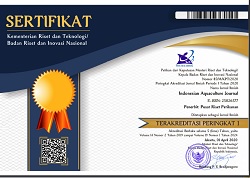NUTRITIVE COMPOSITION OF RED TILAPIA REARED IN FRESHWATER AND BRACKISHWATER
Abstract
The aim of this research was to investigate the nutritive composition (especially fatty acids) in red tilapia that was reared in freshwater and brackishwater. The fatty acid contents were determined by gas chromatography. The fatty acids profile were -3 (linolenic acid, eicosapentaenoic acid/EPA, docosahexaenoic acid/DHA), -6 (linoleic acid, arachidonic acid/AA), and -9 (oleic acid). Red tilapia samples were obtained from Research Institute for Fish Breeding, Sukamandi, West Java (freshwater ponds) and Congot, Yogyakarta (brackishwater ponds; salinity 20 ppt). In this research, red tilapia reared in different ecosystems showed different fatty acid profiles. Red tilapia inhabiting brackishwater ecosystem has EPA (0.26±0.05%), DHA (3.42±0.26%), and linoleic acid (17.20±0.56%) content higher than freshwater ecosystem (EPA = 0%; DHA = 0.67±0.44%; linoleic acid = 9.08±4.76%), except for linolenic acid (0.30±0.15% vs 0.25±0.10%), arachidonic acid (0.77±0.39% vs 0.93±0.13%) and oleic acid (38.67±2.58% vs 37.44±0.74%). The ratio of -6/-3 in red tilapia inhabiting freshwater ecosystem was about 11/1. The culture tilapia in brackishwater ecosystem decrease -6/-3 ratio (4.5:1). So that for human health, it will be better to consume brackishwater red tilapia than freshwater red tilapia.
Keywords
Full Text:
PDFDOI: http://dx.doi.org/10.15578/iaj.7.1.2012.19-27

Indonesian Aquaculture Journal is licensed under a Creative Commons Attribution-ShareAlike 4.0 International License.
















_25.jpg)


